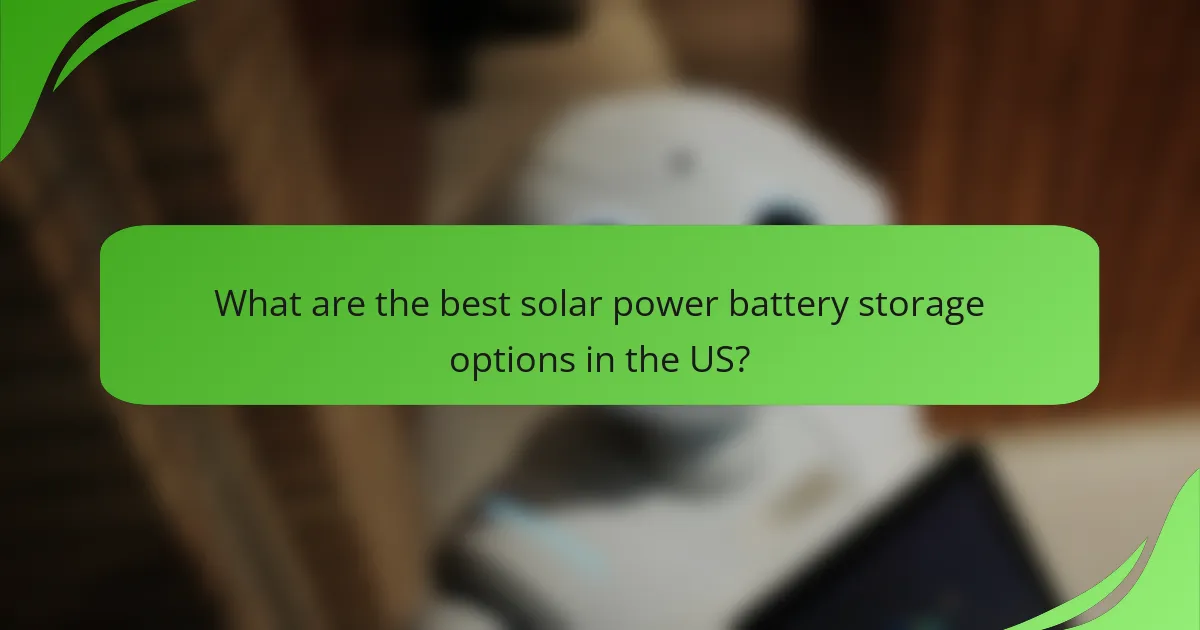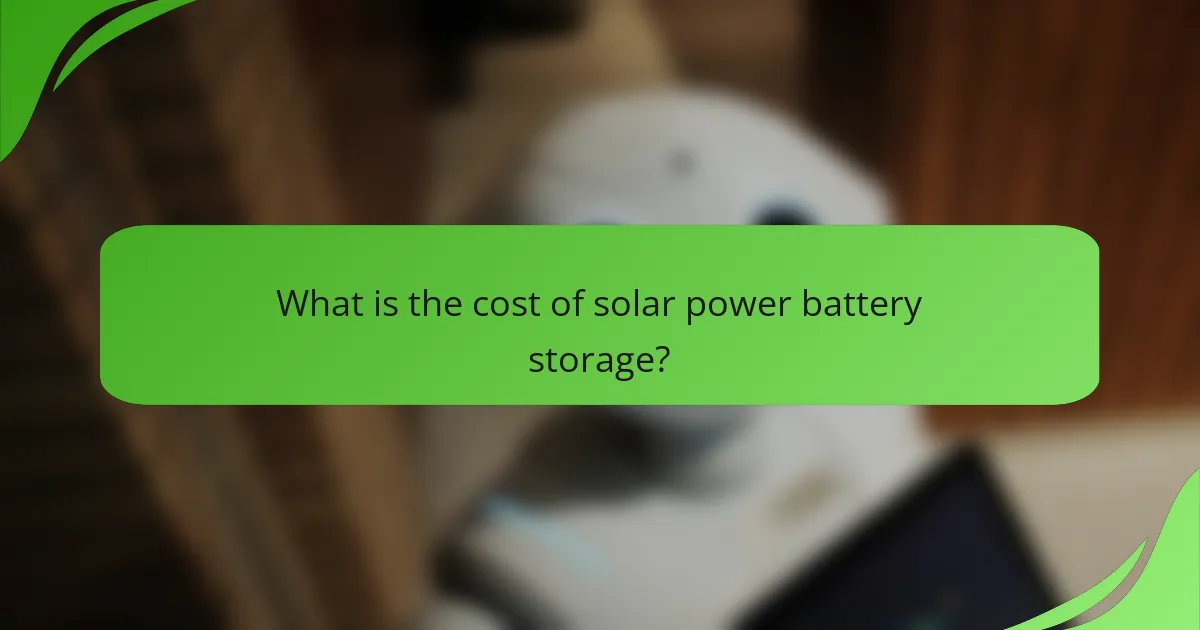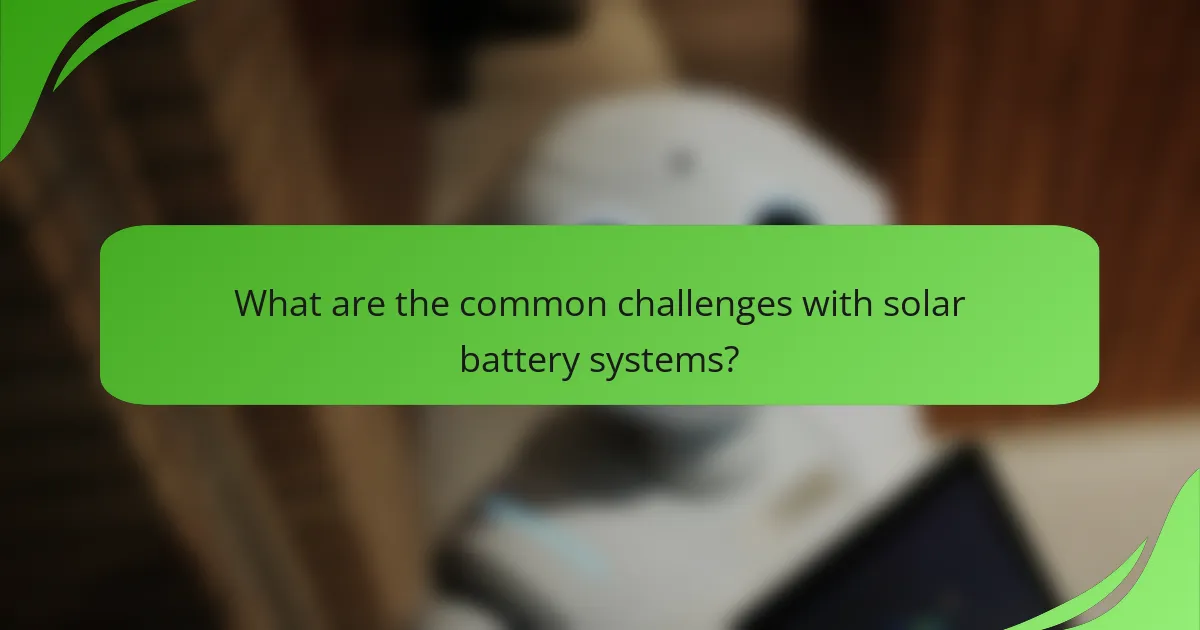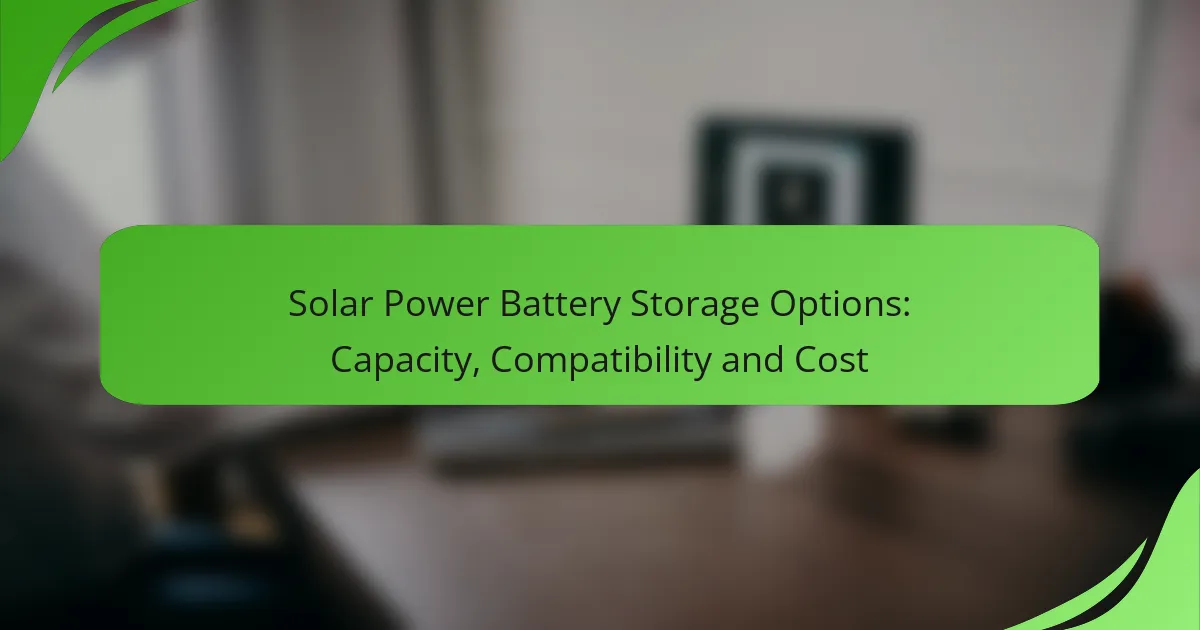Exploring solar power battery storage options is essential for maximizing the efficiency of your solar energy system. With a variety of products available from leading brands like Tesla, LG, and Sonnen, it’s important to consider factors such as capacity, compatibility, and cost to find the best fit for your energy needs. By assessing your household consumption and understanding the intricacies of battery compatibility, you can ensure a reliable and effective solar power solution.

What are the best solar power battery storage options in the US?
The best solar power battery storage options in the US include products that offer high capacity, compatibility with various solar systems, and reasonable costs. Key players like Tesla, LG, Sonnen, Generac, and Enphase provide solutions that cater to different energy needs and budgets.
Tesla Powerwall
The Tesla Powerwall is a popular choice for residential solar energy storage, known for its sleek design and high capacity of around 13.5 kWh. It integrates seamlessly with Tesla solar panels and other systems, providing backup power during outages and optimizing energy use.
Considerations include its relatively high upfront cost, typically in the range of $10,000 to $15,000 installed. However, the long lifespan and warranty of up to 10 years make it a worthwhile investment for many homeowners.
LG Chem RESU
The LG Chem RESU series offers compact battery storage solutions, with capacities ranging from 6.5 kWh to 13 kWh. These batteries are compatible with various inverters, making them versatile for different solar setups.
Pricing for the RESU typically falls between $7,000 and $12,000, depending on the model and installation. Its robust performance and efficiency ratings make it a strong contender in the market.
Sonnen Eco
The Sonnen Eco battery system is designed for energy independence, offering capacities from 10 kWh to 20 kWh. It features smart technology that allows users to manage their energy consumption effectively and even sell excess energy back to the grid.
While the initial investment can be higher, often exceeding $15,000, the Sonnen Eco provides long-term savings on energy bills and a strong warranty of up to 20 years, appealing to environmentally conscious consumers.
Generac PWRcell
The Generac PWRcell is a modular battery storage system that allows users to customize their energy storage capacity, starting from 8.6 kWh and expandable to 34 kWh. This flexibility makes it suitable for various household energy needs.
Prices for the PWRcell system generally range from $9,000 to $15,000, depending on the configuration. Its compatibility with Generac’s solar products enhances its appeal for those already invested in the brand.
Enphase Encharge
The Enphase Encharge battery system is designed for scalability, with options ranging from 3.4 kWh to 10.1 kWh. It works well with Enphase microinverters, providing a reliable solution for homes with existing solar installations.
Costing between $8,000 and $12,000, the Encharge system is known for its efficiency and ease of installation. Homeowners appreciate its ability to integrate with smart home systems for enhanced energy management.

How do I choose the right battery storage capacity?
Choosing the right battery storage capacity involves assessing your energy needs, understanding kilowatt-hours, and evaluating household consumption. This ensures that your solar power system can effectively meet your energy demands without overspending on unnecessary capacity.
Assessing energy needs
Start by determining how much energy your household typically uses. Consider factors such as the number of occupants, types of appliances, and usage patterns. A common approach is to review your electricity bills over the past year to identify average monthly consumption.
Once you have a baseline, think about any future changes that might affect your energy needs, such as adding new appliances or expanding your home. This foresight can help you avoid underestimating your capacity requirements.
Understanding kilowatt-hours
Kilowatt-hours (kWh) measure energy consumption and are crucial for selecting battery capacity. One kWh represents the energy consumed by a 1,000-watt appliance running for one hour. Familiarizing yourself with this unit helps you gauge how much energy your battery needs to store.
For example, if your household consumes about 30 kWh per day, you’ll want a battery system that can store enough energy to cover your needs during low sunlight hours. This often translates to a battery capacity of at least 10-15 kWh for typical households.
Evaluating household consumption
To accurately evaluate household consumption, list all major appliances and their power ratings in watts. Calculate how long each appliance runs daily to estimate their total energy use in kWh. This detailed breakdown will help you understand peak usage times and identify which appliances are energy hogs.
Additionally, consider the benefits of time-of-use rates offered by some utilities. If your utility charges more during peak hours, you may want a larger battery to store energy for use during these times, maximizing savings on your electricity bill.

What factors affect battery compatibility with solar systems?
Battery compatibility with solar systems is influenced by several key factors, including inverter compatibility, battery chemistry, and system voltage. Understanding these elements is crucial for ensuring optimal performance and efficiency of your solar energy setup.
Inverter compatibility
The inverter is a critical component that converts the direct current (DC) from solar panels into alternating current (AC) for home use. To ensure compatibility, the battery must work with the inverter’s specifications, including its voltage and power rating. Mismatched inverters can lead to inefficiencies or even system failure.
When selecting a battery, check the inverter’s compatibility list or consult with the manufacturer. Some inverters are designed to work with specific battery brands or types, which can simplify the installation process and enhance overall system performance.
Battery chemistry
Battery chemistry plays a significant role in determining how well a battery performs with a solar system. Common types include lithium-ion, lead-acid, and flow batteries, each with distinct characteristics. For instance, lithium-ion batteries typically offer higher efficiency and longer lifespans compared to lead-acid batteries.
Consider the charging and discharging rates of the battery chemistry you choose. Lithium-ion batteries can handle faster charging and discharging, making them suitable for systems with high energy demands. Conversely, lead-acid batteries may require more careful management to avoid damage.
System voltage
The system voltage must match the battery’s voltage rating for effective operation. Most residential solar systems operate at 12V, 24V, or 48V. Using a battery with a different voltage can lead to performance issues or even damage to the system.
When planning your solar installation, ensure that all components, including the inverter and battery, are designed for the same voltage level. This alignment helps maximize energy efficiency and prolongs the lifespan of your solar system.

What is the cost of solar power battery storage?
The cost of solar power battery storage varies significantly based on capacity, technology, and installation specifics. Generally, homeowners can expect to invest several thousand dollars for a complete system, including both the batteries and installation fees.
Average installation costs
The average installation costs for solar power battery storage typically range from 5,000 to 15,000 USD, depending on the system’s size and complexity. Factors influencing these costs include the type of battery technology chosen, the installation location, and any additional equipment required, such as inverters or mounting systems.
For example, lithium-ion batteries tend to be more expensive but offer higher efficiency and longer lifespans compared to lead-acid batteries. Homeowners should obtain multiple quotes from certified installers to ensure competitive pricing.
Cost per kilowatt-hour
The cost per kilowatt-hour (kWh) for solar power battery storage can vary widely, often falling between 300 and 700 USD per kWh. This metric helps consumers understand the value of the energy stored and its long-term savings potential.
When evaluating costs, consider the battery’s lifespan and efficiency. A higher upfront cost may be justified if the battery provides more cycles or a longer warranty, ultimately reducing the cost per kWh over time.
Financing options
Financing options for solar power battery storage include cash purchases, loans, and leasing arrangements. Many homeowners opt for loans, which can spread the cost over several years, making the initial investment more manageable.
Additionally, some states offer incentives or rebates that can significantly reduce upfront costs. It’s advisable to research local programs and consult with financial advisors to explore the best financing strategy tailored to individual circumstances.

What are the benefits of solar battery storage?
Solar battery storage provides several advantages, including energy independence, backup power during outages, and enhanced utilization of solar energy. By storing excess energy generated during sunny periods, homeowners can reduce reliance on the grid and ensure a continuous power supply.
Energy independence
Solar battery storage allows homeowners to generate and store their own electricity, reducing dependence on utility companies. This independence can lead to lower electricity bills and protection against rising energy costs. With a well-sized battery system, users can rely on their stored energy during peak pricing hours or when grid prices surge.
To achieve optimal energy independence, consider the size of your solar panel system and battery capacity. A common recommendation is to have a battery that can store at least 50-100% of your daily energy consumption, depending on your usage patterns.
Backup power during outages
One of the key benefits of solar battery storage is the ability to provide backup power during outages. When the grid goes down, a properly configured battery system can automatically supply power to essential appliances, keeping your home functional. This is particularly valuable in areas prone to frequent power interruptions.
To ensure effective backup power, prioritize which circuits or appliances you want to keep running during an outage. Many battery systems allow for selective backup, so you can focus on critical needs like refrigeration, lighting, and medical equipment.
Maximizing solar energy usage
Solar battery storage maximizes the use of solar energy by allowing homeowners to store excess energy generated during the day for use at night or during cloudy periods. This capability can significantly increase the overall efficiency of a solar power system, reducing the amount of energy drawn from the grid.
To maximize solar energy usage, consider investing in a battery system that matches your solar panel output and household energy consumption. A good rule of thumb is to aim for a battery capacity that can store at least one day’s worth of solar production, which can help you utilize more of your generated energy and decrease reliance on grid power.

What are the common challenges with solar battery systems?
Solar battery systems face several challenges that can impact their efficiency and effectiveness. These include issues related to capacity limitations, compatibility with existing solar setups, and varying costs that can affect overall investment.
Capacity limitations
Capacity limitations refer to the amount of energy a battery can store and deliver. Most residential solar batteries typically range from 5 kWh to 15 kWh, which may not be sufficient for larger households or those with high energy demands. It’s crucial to assess your energy usage patterns to determine the right capacity for your needs.
When selecting a battery, consider how much energy you consume daily and how much you want to store for nighttime or cloudy days. Keep in mind that larger capacity batteries often come with higher costs, so balance your needs with your budget.
Compatibility with existing systems
Compatibility issues can arise when integrating solar batteries with existing solar panel systems. Not all batteries work seamlessly with every inverter or solar setup, which can lead to inefficiencies or additional costs for upgrades. It’s essential to check the specifications of both your solar panels and the battery to ensure they can work together effectively.
Consulting with a solar energy professional can help identify compatible options and avoid costly mistakes. Additionally, some manufacturers offer systems designed to work together, simplifying the selection process.
Cost considerations
The cost of solar battery systems can vary widely based on capacity, brand, and technology. On average, prices can range from around $5,000 to $15,000, including installation. While the initial investment may seem high, consider the long-term savings on energy bills and potential incentives available in your area.
When budgeting for a solar battery, factor in not just the purchase price but also installation costs, maintenance, and any necessary upgrades to your solar system. Research local incentives, such as tax credits or rebates, which can significantly reduce your overall expenditure.
